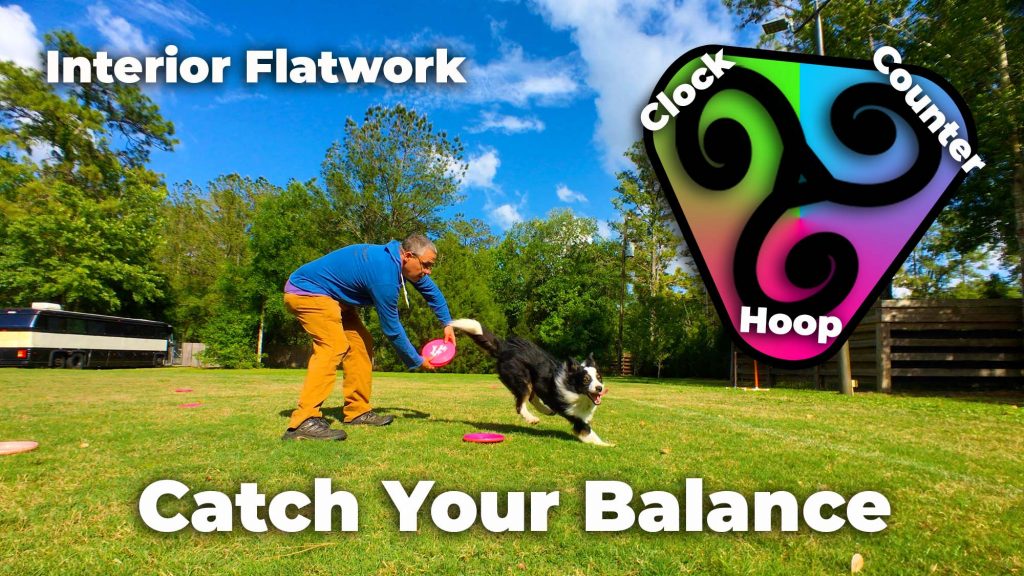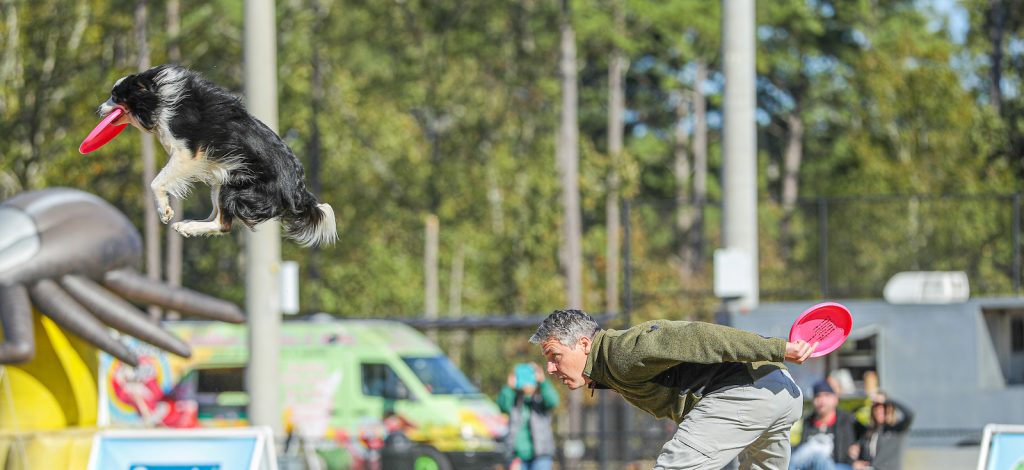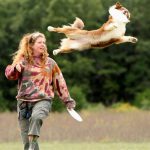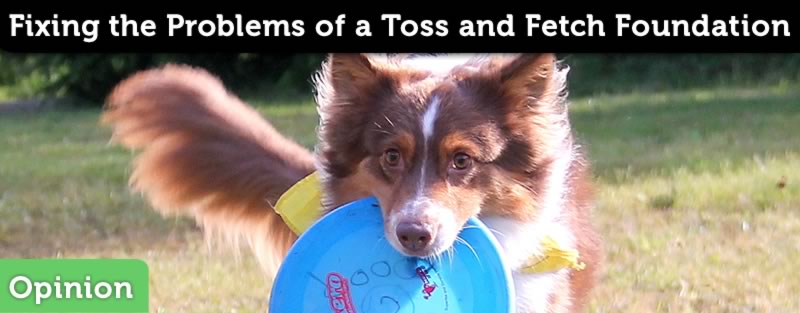
Triads in Dog Training
In dog training, and modern life, we tend to get overly focused on the goal and the impediment standing in front of the goal. In dog training, this means the behavior we want, finished, and the wrong behavior overwhelm our sensibilities and sensemaking.

The Dyad – This or That
The best way to get over a roadblock in positive dog training is to avoid it until the skill is working well enough to challenge and overcome it. The binary dyad, this or that means that you can’t avoid doing the wrong thing, and this is trouble for dog, handler, and team when it comes to building and reinforcing behavior. The dyad approach of this vs that, I want this but I don’t want that, puts us behind the 8-ball and makes learning difficult, frustrating, and slow.
This binary set up, this vs that, is also known as a dyad. Dyads and binary thinking can’t do anything but be on or off – the best you can hope for when working within a dyad, if you are not at the goal yet, is a balance between this or that. On your way to shifting the balance up or down, you can only do the thing you are trying to do or do the thing that you don’t want to do, and because you can’t do it yet, you will be guaranteed to be performing the wrong behavior at least some of the time.
- On
- Off
- Mixed

The Triad – This, That, and the Other
The addition of a 3rd choice that serves 3 functions:
- Anchor
- Movement
- Balance
Anchor & Stability
The dyad, binary choice, doesn’t have an anchor. It is like a measuring stick that either lays down horizontally, or stands up vertically like a pole – this is inherently unstable and unanchored – the pole either falls down due to faulty balance, or the stick rolls around on the ground with prodding. You ever see a single legged stool? The dyad is a monopod. It requires a handler to keep the balance to hold the thing in place.
The triad is like a tripod or a 3 legged stool. It’s anchored and stable. This stable configuration can be played with and adjusted quite easily to anchor and rebalance the situation or your dog training. This leads to flexible training situations where you can change gears and shift focus while leaving the stool standing – anchored and stable – while you do your thing.
Movement & Flexibility
The 3rd position within the triad creates the ability to move the whole apparatus. Without that 3rd position, the dyad can only move up or down within itself. You can’t escape the confines of the pole – the behavior I want and the behavior I don’t want.
The triad, due to that 3rd point of the triangle allows you to roll the whole triangle around and to get different perspectives on the actual shape of the activity. The perspective and movement provided by the triad delivers great flexibility in tackling training problems.
Balance & Control
Standing sticks fall down. Sticks lying on the ground roll. There is no balance in a dyad, just a mix of this and that. And remember that this and that are the thing you want and the thing you don’t want.
If you want actual balance and control you have to add a 3rd point or 3rd perspective. As soon as that is added we can then actually balance the apparatus. We can control where the center of gravity is located and build an object that stands on it’s own and can be adjusted to fit multiple situations.
We can easily push the 3 legged stool across the room. We can even lean it on two legs against the wall. The 3 point perspective yields many balance and control points.
The triad also allows you to create tension between this and that, this and the other, or that and the other. Furthering the ideas of balance & control, movement & flexibility, and Anchor & Stability.
Triads Are Successful
If you look closely you’ll notice that the things you are successful at can easily be broken into a triad. Your breakthroughs in training have most likely come when you add that 3rd perspective to the mix, whether you know it or not.
If you look at what you’re struggling with you will most likely only see the single point of the goal, or a dyad made of the goal and “not the goal”. If you add a thoughtful 3rd point and create a triad, you should see immediate movement towards your goal and should have the ability to make adjustments on the way to your goal.

Triads Create Analogical Intelligence
“An analogy is a comparison between two objects, or systems of objects, that highlights respects in which they are thought to be similar. Analogical reasoning is any type of thinking that relies upon an analogy. An analogical argument is an explicit representation of a form of analogical reasoning that cites accepted similarities between two systems to support the conclusion that some further similarity exists.”
Analogy and Analogical Intelligence/Reasoning are, essentially, the definition of the generalization of knowledge. Funny that we put such strong focus on generalizing our dog’s behavior within our training, but fail to try to generalize our behavior in dog training for the dog, handler, and team.
Once you have used a triad for DriveDrive is focus and energy applied towards work. There are many kinds of Drive: social drive, tracking drive, prey drive, bite/kill, stalking, and food to name a few. Social drive, prey drive, and... More Management, let’s say, in a cookie training situation you should be able to move that Drive Management triad over into a hot game of disc or some other endeavor that deals with Drive Management. Do that a few times and you have generalized your Drive Management dog training ability and will be able to train in the new environment with success and understanding.
Of course it will require additional learning, but that additional learning is not a goal specific skill, and once learned is a generalized improvement in skill. You can even go back to your cookie training with that improved, generalized knowledge and get better in that domain.










This kinda made me think of using shaping in training, which is not an either-or situation, but tiny steps getting closer to a certain behavior. Lots to think about here, Ron, thanks! -Alane
Yeah, I feel you on that. When I ran across this triad concept (via the Cynefin Framework) it immediately put my sensemaking in dog training on another level.
I’ve had this flow chart in my head for “Border Collie Shit” that is like 4 college chalkboards in scale – it’s been there for 20 years now. And within the Cynefin Framework which uses triads for process and practical organizational mechanics (corporate and institutions) I found our dog training techniques function as triads. This enabled me to completely understand and explain that flow chart – game changer.
Here are 10 Triads, literally off the top of my head from the moments after I ran into the triad concept:
Bite | Drop | Give – Disc Dog Mechanics
Reward Placement | CPM | Criteria – Drive Management
Attention | Release | Orientation – DOC – engagement
Attention | Targeting | Dismissal – Slacker Training
Targeting | Dismissal | Attention – Slacker Training Building Desire
Dismissal | Attention | Targeting – Off Switch
Tell | Trigger | Target – Vaulting
Move | Load | Pose – Handler Intangible
Throw | Load | Declare – Handler Intangible
Read | Plan | Do – Action Plan
These are the tools we use within our dog training, and most all the time one of them, usually the pivot or the crux, is completely left out when we’re working.
Knowing them and using them in multiple situations allows us to create maps and analogies that generalize and expand our knowledge.
There is MUCH more coming on this front.
Glad you dug it, Alane.
Peace & Happy Jamming!
Oh man, another rabbit hole… “The idea of the Cynefin framework is that it offers decision-makers a “sense of place” from which to view their perceptions.[8] Cynefin is a Welsh word meaning habitat, haunt, acquainted, familiar.” -Wikipedia.
It makes sense to me to think about the concept of triads with myself first, and get a feel for it, then progress to how to use it with my dog. Looks like a new project! Maybe thanks, lol. -Alane
The Cynefin Framework was a 48 hour deep dive for me. I watched 30 hours of their presentation (Dave & Liz) and read a few hundred pages of their work. I’ll revisit it in a few months to check in on my understanding and development. It’s a super elegant framework and easy to work with.
I did. a few livestreams on this, they’re on the PVybe YT Page: https://youtube.com/pvybe/
And there are some excerpts on PhilosophyDog – https://www.youtube.com/channel/UCEkwcRoaNhFAMZNiKfgMChg
Dog = Handler – Team – Everything that should be obvious (Clear domain in Cynefin) MUST be understood by Dog, handler, and team.
And I wouldn’t wait to try assembling them. Just look for the 3rd rail. Ask here, I’ll be happy to give you some suggestions. I could use the practice and problem solving.
It’s really rather remarkable, actually.
We live in a three-dimensional world. Why would we want to flatten everything to two?
Good stuff Ron!
Right? Super stoked about this, Jeff.